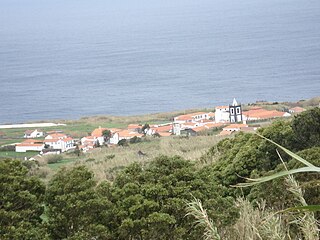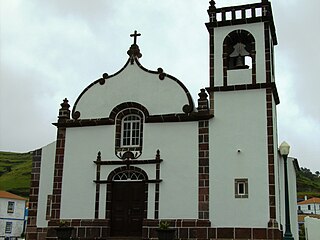
Vila do Porto is the single municipality, the name of the main town and one of the civil parishes on the island of Santa Maria, in the Portuguese archipelago of Azores. Its nearest neighbor, administratively, is the municipality of Povoação on the southern coast of São Miguel, and it is physically southwest of the islets of the Formigas. The population in 2011 was 5,552, in an area of 96.89 km².

Arrifes is a civil parish in the municipality of Ponta Delgada on the island of São Miguel in the Azores. The population in 2011 was 7,086, in an area of 25.37 km².

Ribeira Grande is a municipality in the northern part of the island of São Miguel in the Portuguese Azores. The population in 2011 was 32,112, in an area of 180.15 km2. The municipal seat is located in the civil parish of Matriz, with a population of about 4000 inhabitants, part of the urbanized core of what is commonly referred to as the city of Ribeira Grande.

Vila Franca do Campo is a town and municipality in the southern part of the island of São Miguel in the Portuguese Autonomous Region of the Azores. The population of the municipality was 11,229 in 2011, in an area of 77.97 km². The town proper, which incorporates the urbanized parishes São Miguel and São Pedro, has 4100 inhabitants.

Povoação is a municipality located in the southeastern corner of the island of São Miguel in the Portuguese archipelago of the Azores. The population in 2011 was 6,327, in an area of 106.41 km².

Almagreira is a civil parish in the municipality of Vila do Porto on the island of Santa Maria, in the Portuguese autonomous region of Azores. The population in 2011 was 599, in an area of 11.22 km². Bordering all other parishes of the island, it is located northwest of Vila do Porto.

Vila do Porto is a civil parish in the municipality of Vila do Porto, located on the island of Santa Maria, in the Portuguese autonomous region of Azores. It is the southernmost and easternmost parish in the archipelago of Azores. The population in 2011 was 3,119, in an area of 25.55 km².

The Church of Santa Bárbara is a church in the civil parish of Cedros, municipality of Horta, on the Portuguese island of Faial in the archipelago of the Azores. Its parish falls within the Roman Catholic Diocese of Angra, and serves the parishioners of the northern coast from the border with Salão to Ribeira Funda.

The Church of Nossa Senhora dos Milagres is a Portuguese 16th-century church located in the municipality of Vila do Corvo, on the island of Corvo in the archipelago of the Azores.

The Church of Santa Bárbara is a Roman Catholic church in the civil parish of Santa Bárbara, municipality of Vila do Porto, in the archipelago of the Azores. Located in the valley of the same name, the parochial church of Santa Bárbara was constructed sometime in the early 15th century and served the impoverished parish throughout its history, supported by personal donations and community assistance.

The Church of Santa Cruz is a Catholic church situated in the civil parish of Santa Cruz, in the municipality of Lagoa, in the Portuguese archipelago of the Azores.

The Church of Nossa Senhora do Guadalupe, is a Portuguese church in civil parish of Guadalupe, in the municipality of Santa Cruz da Graciosa, on the island of Graciosa in the archipelago of the Azores.

The Church of Nossa Senhora dos Remédios is an 18th-century church located in the civil parish of Fajãzinha in the municipality of Lajes das Flores, in the Portuguese island of Flores, in the archipelago of the Azores.
The Church of Santíssima Trindade is an 18th-century church located in the civil parish of Fazenda in the municipality of Lajes das Flores, in the Portuguese island of Flores, in the archipelago of the Azores.
The Church of Nossa Senhora dos Milagres is an 18th-century church located in the civil parish of Lajedo in the municipality of Lajes das Flores, in the Portuguese island of Flores, in the archipelago of the Azores.
The Church of Nossa Senhora do Rosário is an 18th-century church located in the civil parish of Lajes in the municipality of Lajes das Flores, in the Portuguese island of Flores, in the archipelago of the Azores.
The Church of São Caetano is a 17th-century church located in the civil parish of Lomba in the municipality of Lajes das Flores, in the Portuguese island of Flores, in the archipelago of the Azores.
The Church of Benditas Almas is a 19th-century church located in the civil parish of Caveira in the municipality of Santa Cruz das Flores, in the Portuguese island of Flores, in the archipelago of the Azores.

The Church of Nossa Senhora da Conceição is an 18th-century church located in the civil parish of Santa Cruz in the municipality of Santa Cruz das Flores, in the Portuguese island of Flores, in the archipelago of the Azores.

















